COMPETITIVE RIFLE SHOOTING IN WOLVERHAMPTON FROM 1945
by Frank Spittle
1. NARPA and Air Rifle and Pistol Shooting after
World War II
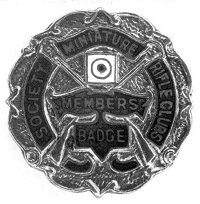 |
The Society of Miniature Rifle Clubs suspended air
rifle shooting during the Second World War. Under its postwar title
of The National Small Bore Rifle Association it declared, in a
letter from the secretary Mr Jerry Palmer to Frank Spittle, that the
National Small Bore Rifle Association was not interested in air
rifle shooting at that time. Moves by an awakening group of bell
target and paper target shooters in the Hinkley and Northampton
areas in the 1960s to form some reorganisation for the air rifle
sport, saw the emergence of a new organisation, the Air Rifle Clubs
Association. |
| Its secretary
and organiser, Mr Dennis Commins of Northampton, is one of the
unsung heroes of shooting sport. The re-establishment of competitive
airgun shooting, particularly at the six yard distance in this
country is, in the main, down to him and his committee. Recognition
by the Central Council for Physical Recreation followed, but it
would be fair to say here that this was due to the direct
intervention by a senior member of the Royal Household, the Duke of
Edinburgh, who was chairman of the C.C.P.R.. In 1973 he said that he
considered that there was only one organisation for air gun shooting
that was worthy of the title ‘National’, and this was conferred upon
the Air Rifle Clubs Association. |
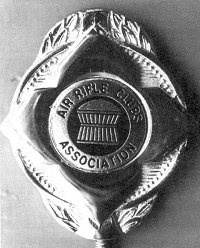 |
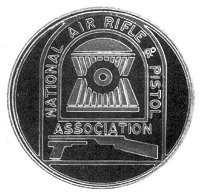 |
They changed their name to the National Air Rifle
and Pistol Association. During these developing days of NARPA the first National Championships
were held at Rushden in Northamptonshire, soon to be followed by the
immensely successful Cosford events, one of which coincided with the
aircraft museum open day and saw thousands of people at the
championships. |
| During this time, the Gun Trade Association Members and their ‘Sporting
Trust’, gave wonderful support to this fledgling new organisation for
air rifle and air pistol sport.
The air pistol was now of equal
importance in the competitions. Guns Review proprietor, Mr. Tee,
gave his support in money and in the printing of paper targets. |
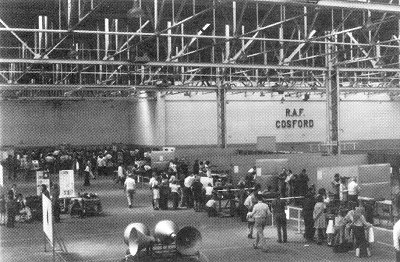
NARPA Championships at RAF Cosford. |
|
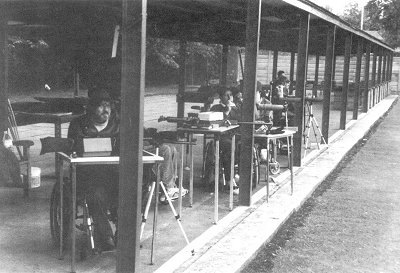
Wheelchair shooters on the Aldersley Rifle Range. |
Millard Brothers of Scotland on once occasion gave a cheque
for several thousand pounds. Webley and Scott, B.S.A., among the other members of the gun
trade, did the sport proud. |
|
In 1974 representatives of N.A.R.P.A. at the Bournemouth Conference of
the Central Council for Physical Recreation, (C.C.P.R.) had the
satisfaction of seeing their efforts on behalf of disabled members of
airgun shooting accepted by Sir Ludwig Guttman, the founder of the Stoke
Mandeville Centre, into the area of wheelchair sports. It would be fair
to say that initially he was very much against shooting of any sort. It
was perhaps the demonstration of the Sport of Air Gun shooting, and an
exhibition of shooting equipment, by Wolverhampton enthusiasts in 1975,
at Stoke Mandeville, that proved that here was a new sport for disabled
people, giving them an entry into a sport of the able bodied. Twenty
years later, advanced electronic sighting equipment was used in the new
National Indoor Centre at Aldersley Stadium, Wolverhampton, that opened
the way to visually impaired and blind sports people to take their place
on the firing point.
Another very important step in the progress of N.A.R.P.A. was the
Sports Council’s decision to pay the salary of a National Development
Officer for Air Gun shooting in Britain. He was based first in
Northampton, and then in the town centre of Bridgnorth, Shropshire.
When a Cosford national championships had to be cancelled owing to a
clash of dates at the R.A.F. base, another venue had to be found in the
Wolverhampton area. Hilton Equestrian Centre, just north of
Wolverhampton, was ideal, apart from the floor which was of loose
material to accommodate the horse riders using the centre. |
| The championships were such a success that they
were drawing people who arrived carrying sporting air guns with
telescopic sights. Rather than turn them away, it was decided that
they would be allowed to compete among themselves on the field
alongside the building. These were then classed as the ‘Field
Target’ shooters, and a special Outdoor Shooting section was formed
with the title N.A.R.P.A. Outdoor Shooting Section, O.S.S.. |
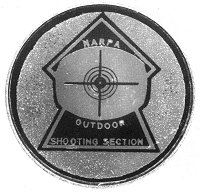 |
| From such small beginnings, and due again to people with foresight,
Field Target with the air rifle became an important national sport. This
advanced form of air rifle competition is recognised by the National
Rifle Association at Bisley by the provision of an excellent site near
the Running Target Range. Another important venture that involved N.A.R.P.A., was persuading the
management of Bilston Swimming Baths in the West Midlands, to provide
the only permanent municipal air rifle range in the country, having ten
lanes with electronic target changers plus three Bell Target places.
This was placed in the area underneath the pool and was opened by the
Mayor in 1974 with a match between Town Councillors and Council
Officers.
|
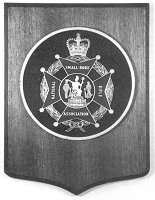 N.S.B.R.A. badge on a presentation plaque.
N.S.B.R.A. badge on a presentation plaque. |
In 1975, a site for the new National Air Rifle
Centre had been provided by Wolverhampton Council, but was opposed
by the National Small Bore Rifle Association on the grounds that it
should be at Bisley. This led to some bitterness by N.A.R.P.A., who
had done so much for the grass roots air gun shooter, whose main
discipline was at the six yards distance with card or bell target,
and not the international distance of ten metres that was now
beginning to become increasingly popular with the National Small
Bore Rifle Association, the accepted body controlling international
shooting.
For a while, members of both organisations, N.A.R.P.A. and the
N.S.R.A., accepted competitors into their competitions. |
| But it soon became apparent that the senior body, The National Small
Bore Rifle Association, with a vastly larger membership, Sports Council
funding, and the only way forward to International status for an
aspiring airgun shooter, would soon dominate national participation with
the air rifle and pistol. Another very important factor was that the
N.S.R.A. was a ‘trading body’, enjoying the best of both worlds of
Sports Council support and raising capital through trading, enabling it
to employ full time staff to run its affairs and give a far superior
service to shooters. The National Air Rifle and Pistol Association, on
the other hand, had only the Sports Council assistance for its
Development Officer’s salary and could hardly set up in opposition to
the gun trade that had so splendidly supported them, by selling direct
to its membership. |
| It was becoming obvious that N.A.R.P.A. would soon have to
cease its activities in the area in which it was doing the most
good: at the grass roots of shooting interest.
But it shouldered one last responsibility of the National
shooting organisations when it volunteered to produce air rifle
instructors for ‘Action Sport’. |
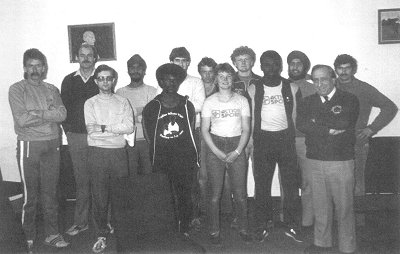
Air rifle coaches course. |
| This was a Sports Council’s initiative for providing Action
Sporting Centres for the use of the under privileged and out of
work victims of the depression. Using rifles
and shooting equipment generously loaned by a Midland firm, over thirty
instructors were passed out at Wolverhampton, Sandwell and Dudley. The
first of these Centre managers to qualify for shooting instructor
certificates were Mr Josh Johnson, British Karate Champion, Mr Geoff
Pond and Mr Tony Rains. The then Director of Action Sport, West
Midlands, Mr Derek Anderson, made the presentations to the managers at
the Park Village Recreational Centre, Wolverhampton. |
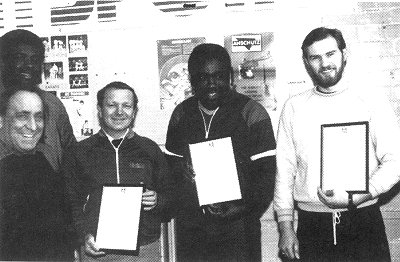 |
Action Sport's Air Rifle Coach's Course presentation
at the Park Lane Centre, Wolverhampton. Left to right:
Derek
Anderson (Director, Action Sport), Tony Raines, Josh Johnson, Geoff
Pond; and Frank Spittle, front left. |
| The National Air Rifle and Pistol Association closed its doors in 1980
at Bridgnorth Town Centre Shropshire, a victim of its own success. It
had given over ten years of wonderful effort to airgun shooting by
re-establishing the interest in the sport that has had such an important
influence on British shooting since 1900. Many regretted the passing of the N.A.R.P.A. organisation, that had
succeeded by the way of the voluntary effort and work of its membership
and unpaid staff. A part of shooting history it may be, but some of the
older and, in the main, Birmingham, Black Country, or central England
shooting fraternity, bell and six yard participants, still look back
with justified pride on how much they achieved, with so little. Most of
all, perhaps, was the enjoyment they had doing it.
When the National Smallbore Rifle Association assumed the now defunct
National Air Rifle and Pistol responsibilities, it did at least inherit
the benefit of financial assistance from the Sports Council for a
Development Officer for airgun shooting, and a well presented training
scheme manual, for developing airgun shooting and clubs at basic and
grass root level. These were handed to Mr Ron Russell, secretary of the
N.S.R.A. on the demise of the National Air Rifle and Pistol Association.
It also had the site at Aldersley, Wolverhampton, for the provision of
a National Centre, that had been continuously striven for since 1970,
the birth centre of air rifle sport in the United Kingdom.
|
 |
|
 |
Return to the
beginning |
|
Proceed to the
next page |
|